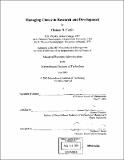| dc.contributor.advisor | Eleanor Westney. | en_US |
| dc.contributor.author | Curtin, Thomas B. (Thomas Brian), 1945- | en_US |
| dc.contributor.other | Sloan School of Management. | en_US |
| dc.date.accessioned | 2006-03-24T16:17:22Z | |
| dc.date.available | 2006-03-24T16:17:22Z | |
| dc.date.copyright | 2003 | en_US |
| dc.date.issued | 2003 | en_US |
| dc.identifier.uri | http://hdl.handle.net/1721.1/29709 | |
| dc.description | Thesis (M.B.A.)--Massachusetts Institute of Technology, Sloan School of Management, 2003. | en_US |
| dc.description | Includes bibliographical references (leaves 41-49). | en_US |
| dc.description.abstract | Effective innovation is the product of an iterative series of key decisions by lead researchers, lead users, and lead sponsors/investors. Lead sponsors are critical. Sponsors at the efficient frontier creatively link technical communities and potential markets. The value of research and development (R&D) lies primarily in creating choices; R&D managers add value by managing choice effectively. An approach has been developed to align portfolio balance with strategic balance in managing R&D. A system dynamics model is used for strategy and a real option model for portfolios, calibrated with data from the Office of Naval Research. An implied risk strategy has been determined describing how managers have historically made R&D choices. With this profile, historical R&D budget allocations from 1962 to the present have produced of order one commercial product annually. A strategy for maximizing product development rate is described. From the perspective of a manager choosing specific projects to fund, the three phase R&D model can be viewed as a compound call option. An R&D Factor quantifies R&D contributions to the total value of effective innovation. Technical Readiness Levels (Technical Risk), Market Readiness Levels (Market Risk) and Network Connection Levels (Diversity Risk) comprise a three component risk vector whose magnitude is the project Volatility Index. Option value, calculated for a set of ONR-relevant product classes, is found to change investment decisions. Sensitivity studies reveal a critical transition interval in volatility, where managerial effort should be focused. Two organizational questions underlie this work. How can corporate managers propagate strategy without micromanagement? How can portfolio managers align project investment choices with corporate strategy without losing flexibility? To strike a balance, mechanisms for alignment of choices have been constructed. Corporate strategy is linked to portfolio management in aggregate balance through budget ratios related to target output, and in specific project prioritization through market risk parameterizations. Implications about organizational structure are discussed. | en_US |
| dc.description.statementofresponsibility | by Thomas B. Curtin. | en_US |
| dc.format.extent | 107 leaves | en_US |
| dc.format.extent | 5262755 bytes | |
| dc.format.extent | 5262564 bytes | |
| dc.format.mimetype | application/pdf | |
| dc.format.mimetype | application/pdf | |
| dc.language.iso | eng | en_US |
| dc.publisher | Massachusetts Institute of Technology | en_US |
| dc.rights | M.I.T. theses are protected by copyright. They may be viewed from this source for any purpose, but reproduction or distribution in any format is prohibited without written permission. See provided URL for inquiries about permission. | en_US |
| dc.rights.uri | http://dspace.mit.edu/handle/1721.1/7582 | |
| dc.subject | Sloan School of Management. | en_US |
| dc.title | Managing choice in research and development | en_US |
| dc.title.alternative | Managing choice in R&D | en_US |
| dc.type | Thesis | en_US |
| dc.description.degree | M.B.A. | en_US |
| dc.contributor.department | Sloan School of Management | |
| dc.identifier.oclc | 53982754 | en_US |
